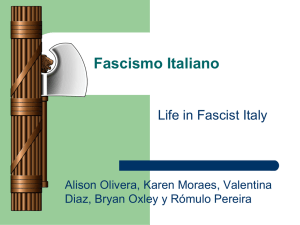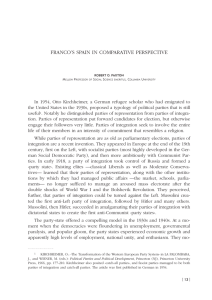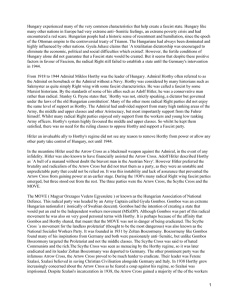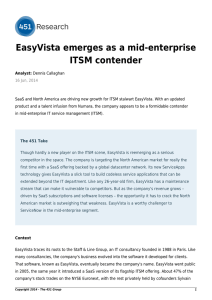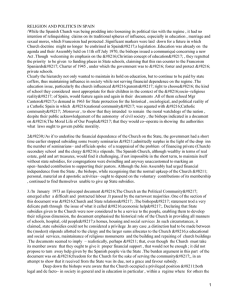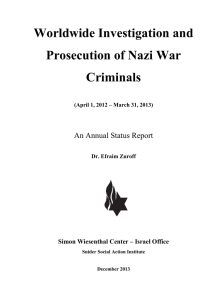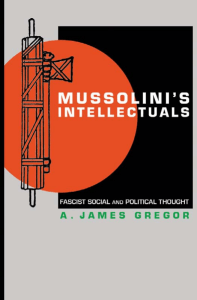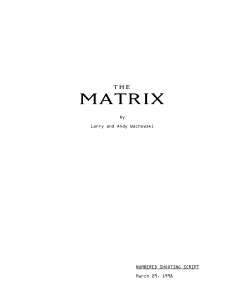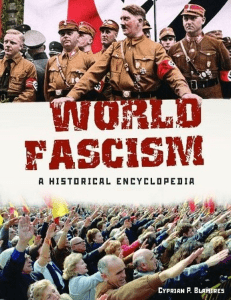Neofascism
Anuncio
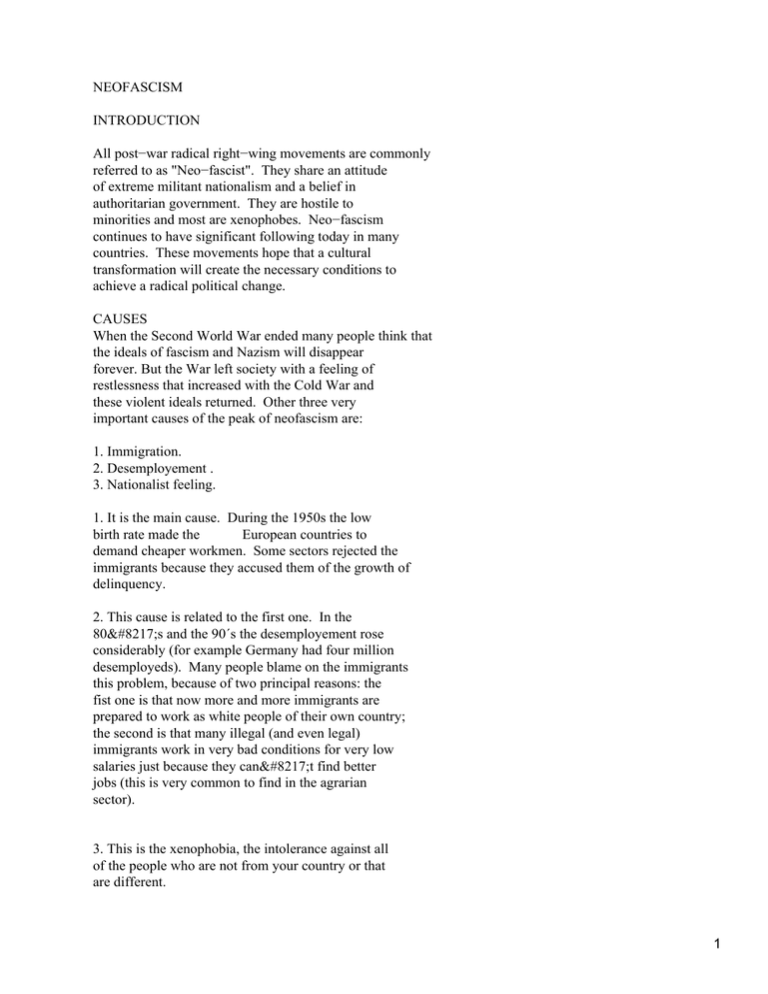
NEOFASCISM INTRODUCTION All post−war radical right−wing movements are commonly referred to as "Neo−fascist". They share an attitude of extreme militant nationalism and a belief in authoritarian government. They are hostile to minorities and most are xenophobes. Neo−fascism continues to have significant following today in many countries. These movements hope that a cultural transformation will create the necessary conditions to achieve a radical political change. CAUSES When the Second World War ended many people think that the ideals of fascism and Nazism will disappear forever. But the War left society with a feeling of restlessness that increased with the Cold War and these violent ideals returned. Other three very important causes of the peak of neofascism are: 1. Immigration. 2. Desemployement . 3. Nationalist feeling. 1. It is the main cause. During the 1950s the low birth rate made the European countries to demand cheaper workmen. Some sectors rejected the immigrants because they accused them of the growth of delinquency. 2. This cause is related to the first one. In the 80&#8217;s and the 90´s the desemployement rose considerably (for example Germany had four million desemployeds). Many people blame on the immigrants this problem, because of two principal reasons: the fist one is that now more and more immigrants are prepared to work as white people of their own country; the second is that many illegal (and even legal) immigrants work in very bad conditions for very low salaries just because they can&#8217;t find better jobs (this is very common to find in the agrarian sector). 3. This is the xenophobia, the intolerance against all of the people who are not from your country or that are different. 1 DEMONSTRATIONS &#61623; ACADEMIC NEOFASCISM: This form of neofascism is seen in the scholarly industry that publishes propaganda in an academic style to play down, or excuse the horrors of Nazism. This approach is sometimes called historical revisionism, although it is separate from a much more general and mainstream approach to history known as revisionism. Some of these scholars manipulate documentary evidence to "prove" that the Nazis did not create extermination camps that killed millions of Jews during the Holocaust. All professional historians completely reject any attempt to show that the Holocaust never happened, but there continues to be a number of fascist writers who try to deny the atrocities that the Nazis committed. The Internet has made it much easier for these writers to spread their ideas and propaganda, in a way that it is practically impossible to censor them. We have a clear example on Robert Faurisson. He was an associate professor of French literature at the University of Lyon. He wrote several articles for the newspaper Le Monde (and other important French newspapers) talking about the non−existence of gas chambers. He was said to be an &#8220;expert&#8221; in investigation of truth and falsehood. In 1981 he was expelled from the University because he had been trying to teach his ideals in there. This is not the common thing to happen, there are many teachers that still teach this ideals. Other example of academic neofascism is seen in many musical gangs, which are distributed by fascist record companies. The first skinhead concert in Madrid took place on November 1998 (it was organised by a group of Hammerskins), as it were a success the groups decided to organise another advising it to their comrades expecting more people to go. They as well wanted to see the System&#8217;s reaction. Some of these gangs are: 7 Muelles, Gesta Bélico, Batallón de Castgo, Torquemada 1488, Zeteme88 and Jungsturm (they are all Spanish and have a lot of prosperity among Spanish Neo−nazis). &#61623; POLITICAL NEOFASCISM: 2 Some fascists have tried to form political parties to participate in government. In contrast to the first fascist movements, these new fascist parties do not rely on the army to fight their opponents. To make fascist ideas seem acceptable, some parties softened their revolutionary methods in order to win vote support even from people who do not want a radical change or a fascist regime. Instead of emphasizing their long−term objectives for change, the fascist parties focus on issues such as the threat of Communism, crime, global economic competition, the loss of cultural identity (resulting from mass immigration), and the need for a strong, charismatic leader to give the nation the right direction. Italy, for example, saw this type of &#8220;democratic&#8221; fascism with the 1946 formation of the Movimento Sociale Italiano (MSI), which hoped to keep fascist ideals alive. In the mid−1990s the MSI managed to widen its support significantly when it renounced the goals of historic Italian Fascism and changed its name to the National Alliance (Alleanza Nazionale). During the 1990s several other extreme−right parties gained significant social support, as the Republicans (Die Republikaner) in Germany, but fell down when the Christian Democratic Union promoted very hard laws against the immigrants, the National Front (Front National) in France, the Freedom Movement (Die Freiheitlichen) in Austria, the Flemish Block (Vlaamsblok) in Belgium, and the Liberal Democratic Party in Russia. All of these groups have some fascist elements, but reject the radicalism and violence of true fascism. &#61623; SOCIAL NEOFASCISM: One of the most important new fascist strategies is to form small groups of idealist people willing to dedicate their lives to the fascist cause, but also you find illiterate people that simply wanted to be accepted. In some cases these minor groups turn to terrorism. Since 1945, fascists in Western Europe and the United States formed many thousands of small groups, form thousands of members to less than ten. Many of them are dissolved or change names after a few years, and members sometimes move through a number of groups or even belong to several at once. Although the groups often use attractive slogans and claim that their forces will create a severe social crisis, in practice they remain unable to change the society or politics. 3 These groups remain ineffective because they fail to attract mass support. Despite their weaknesses, these small fascist groups cannot be dismissed as insignificant. Some of them have been known to carry out acts of violence against individuals. In 1997 in Denmark, for example, a fascist group was accused of sending bombs through the mail to assassinate political opponents. In the United States, fascists have assaulted and killed African Americans, Jews, and other minorities, and set off scores of bombs. Another example is the case of Aitor Zabaleta who has been killed by a member of a neo−nazi Spanish group. Small fascist groups also present a threat because the propaganda they distribute and the marches and meetings they hold can create a local climate of racial intolerance. This encourages discrimination (from verbal abuse to murder). In addition, the small size and lack of centralized organization that weakens these groups also makes them almost impossible for governments to control. If a government stops violence by arresting members of a few groups, the larger fascist network remains intact. This guarantees that the ideology of fascism will survive even if government authorities clamp down on some organizations. SYMBOLISM SPANISH NEO−NAZI GROUPS &#61623; MAJOR GROUPS At least fourteen neo−nazi groups and several small associations are acting in Madrid since last year. This means that Madrid has the largest number of Nazi movements. These groups are mainly made up by skin heads (how are normally young middle class people with fascist and nazi beliefs, and who hate homosexuals, prostitutes, immigrants and indigents. These fourteen groups are divided in the ones that act in the capital: Skins Majadahonda, Skins Vallecas, Skins Barrio del Pilar, Revolución Joven Skin, Skins Moncloa, Skins Cubos (Plaza de España), and Juventud Nacional Revolucionaria; and the ones which act in the whole Community: La Voz del Pueblo (Alcorcón), Hammerskin (Fuenlabrada), Ultras Parla, Boys Leganés, Frente Joven (Alcalá de Henares), Resistencia Blanca 4 (Getafe) and Camaradas Presos (Alcalá de Henares). These groups are menace considering that most of them are conected (thanks to Internet) to each other and to their European &#8220;brothers&#8221;. If we focus on Hammerskin, for example, we can see that is not simply a Spanish group, but has other seats in California (USA), Florida (USA), Vinland (Canada), Southern Cross, and Britain. Hammerskin criticise openly the National Socialists, leftist groups (as the Redskins), or simply the Basque Country, Galicia and Cataluña. They try to explain their European comrades the separatist situation of Spain and make propaganda of neo−fascist music bands. The symbols of the Hammerskins are different for each country, so at the left is the Internatinal Flag and at the right the Spanish one. There are more flags, but they are all very similar. &#61623; ULTRAS The football is one of the favourite surroundings for the meeting of extreme rightist movements. There they are protected by the pacific masses and are prepared to act if necessary. Each weekend, only in Madrid 3,700 to 4,500 ultras go to the four mayor stadiums of the Capital. The Movimiento Contra la Intolerancia (MIC) has published recently in the Third Raxen Inform the following datums: &#61623; The Frente Atlético convokes 2,500/3,000 young rightextremist. &#61623; Ultrasur about 1,000 or 1,500. &#61623; Comandos Azules (Getafe) more than 100. &#61623; Leganés Boys more or less 100. Not all of these groups&#8217; members are skinheads, but are integrated in Neo fascist groups . Esteban Ibarra, president of MIC has announced that Madrid is the Spanish region with the highest presence of ultras. But this doesn&#8217;t mean that there aren&#8217;t other organizations in the rest of Spain. Two inspectors of the Cuerpo Nacional de Policía have 5 done a map of autonomies with the distribution of the ultra violent groups, but we are going to concentrate in the ones with neo−fascist ideals, because there are other which have socialist and communist thoughts: &#61623; Asturias: they are called Ultra Boys del Sporting they sum up 450 members more or less. &#61623; Andalucía: the 300 sympathisers of the Supporters Gol Sur describe themselves as extreme−rightist, specially a clump of twenty skinheads that use nazi symbolism and flags. &#61623; Aragón: the Ligallo Fondo Norte del Zaragoza hates the Basque teams. It is composed of 300 people among you can find 40 nazi skinheads. &#61623; Castilla y León: within the 300 associates of the Ultras Violetas del Real Valladolid there are only 30 rightist skinheads. &#61623; Castilla−La Mancha: the most important and known neo−fascist clusters here are the Brigadas Blancas, Komandos Verdes and Escuadra Imperial. &#61623; Extremadura: the two significant groups here are the Legiones Sur de Mérida and the Infierno Pacense del Badajoz. Both of them hate each other. &#61623; La Rioja: the Gaunas Sur, who are extreme−rightist. &#61623; Cataluña: the 800 Boixos Nois de Barcelona are the one most fierce sets, having more than 150 rightist skinheads and about 200 that aren&#8217;t skinheads but support fascist ideals. The Brigadas Blanquiazules have also 150 skinheads approximately. &#61623; Valencia: the skin−right movements are: the Yomus y Gol Gran, the Jove Elx de Elche, Las Banderas del Hércules and the Ultras Levante. At the beginning all of these brackets had the support of the football team they belonged to, they were even paid by them, who used the groups to &#8220;protect&#8221; their players and intimidate the adversaries. This ended when the clubs were blamed on the brutal acts the ultras committed. All of those knots have their common enemies (which 6 are mentioned before) that are the punks, the red skins (they believe in socialism), the sharps (skinheads who are against racism), the Symmachiarii (who defend anarchism), and many more. &#61623; FACTS Approximately there are sixty−five Neonazi groups in Spain. They are organised and have developed a strategy to arrive to their purpose: launch a political party. Thanks to a web page in Miami (Nuevorden−Hispania Gothorum) they are having more and more probabilities of achieving their goal. Being in Miami is advantage, because this way they are avoiding the Spanish justice that prohibits these types of associations. This web page incorporates thousands of nationalist contacts all over the world that interchange ideas, teach their doctrines and project demonstrations to those sixty−five (more or less) groups that act in Spain. The representatives of this page maintain that they have always tried to help the people to organise in and for the legality. They want to co−ordinate the already existent groups and also, in a near future, they want to suppress the swastika, with this manner they will gain more mass support. Nuevorden−Hispania Gothorum encourages young, but prepared people to support this movement with a message of hate: << Not all the revolutions are good&#8230;Only those which favoured our race. >> &#61623; CURRENT EVENTS AITOR ZABALETA CASE Aitor Zabaleta was killed the 8th of December of 1998 by an ultra group of neo−nazis, followers of the Atlético de Madrid Bastión 1903 near the Vicente Calderón stadium. He had more than seven stabs through all his body. The principal accused, Ricardo Guerra gave the mortal one. The Audiencia Provincial judgement began the 28th February 2000. The principal accused is Ricardo Guerra, but there are three more implicates, Ignacio Racionero, Israel Gonzalo Canabal and Iván Martín Ron. A popular jury decided that Ricardo Guerra was guilty of the murder of Aitor Zabaleta. 7 The sentence says that he has to spend 17 years in prison. The judge had decided that Ricardo Guerra has to pay 20 million pesetas as compensation for the death of Aitor Zabaleta, and, doing an exception, the girlfriend is going to receive 10 million as a compensation for the damages caused by the aggressor The family of Aitor is happy with the sentence; but they are waiting for the judgement against other 12 members of the neonazi &#8220;Bastión&#8221;. They don&#8217;t want that this &#8220;people&#8221; get away with their crime. They want justice. CONCLUSION First of all we think that if there are about sixty−five Spanish Neo−nazi groups co−ordinated among themselves this means that they aren&#8217;t as inoffensive as Government tries to show, so it would be a good idea to take steps against this assemblages before they take steps against democracy. We are totally against any fascist or nazi ideas. We can&#8217;t believe that at the end of the XX century (or at the beginning of the XXI century) there are people who still accept these retrogressive ideas. Teaching the atrocities that Hitler&#8217;s, Mussolini&#8217;s or other dictator&#8217;s followers did under an objective point of view, and showing what immoral and savage were, is something that we think will help decrease the number of people that want to participate in this kind of clumps. 8
